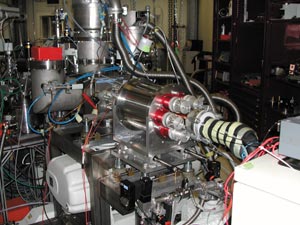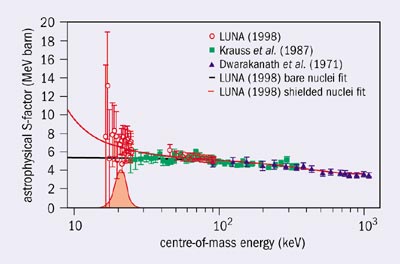Observing what goes on in the heart of stars from deep below ground is an effective tool for understanding stellar interiors and the primordial universe, as Gianni Fiorentini and Alessandro Pascolini explain.

Aristotle’s report that “men in pits or wells sometimes see the stars”, made in On the Generation of Animals (book V, chapter 1), is a legend that was long believed, persisting until the 20th century without being experimentally tested. Similar stories were reported by Giambattista della Porta in 1560, Christof Schneider in 1626, John Herschel in 1836 and Charles Dickens in 1837, among others. But sunlight scattered from air molecules is generally much brighter than the brightest starlight, so it is impossible to see stars with the naked eye during daylight hours, no matter where one is looking from. Physicists today, however, have found methods for looking into stars from the bowels of a mountain. In addition to the observations of solar and supernova neutrinos, nuclear reactions of astrophysical interest are now being studied underground.
LUNA, the Laboratory for Underground Nuclear Astrophysics at Gran Sasso, has recently measured the cross-section for p + 14N → 15O + γ, the key reaction of the CNO cycle that fuels stars heavier than the Sun (see figure 1) (LUNA 2004). Shielding against cosmic radiation provided by the surrounding mountain has allowed measurements down to a centre-of-mass energy of 130 keV, and lower energies, close to those of stellar burning, are currently being explored. With the LUNA value of the astrophysical S-factor (a measure of the strength of the nuclear interaction) being about half that previously estimated, the predicted flux of solar neutrinos from the CNO cycle has correspondingly been halved and the age of the galaxy, as deduced from the stellar evolution of globular clusters, has been increased by about one billion years (see figure 2) (Degl’Innocenti et al. 2004).

LUNA was conceived during the conference dinner of “Nuclei in the Cosmos ’90”, which was held at Baden bei Wien in Austria. During hors d’oeuvre, Gianni Fiorentini from the University of Ferrara asked Claus Rolfs of the University of Bochum why nuclear reactions could not be measured in the laboratory at the energies at which they occur in stars. The answer was that cosmic radiation provides a formidable background for detecting the extremely slow reaction rates at these energies. By the time of dessert, they had realized that the solution was to install an accelerator in an underground laboratory. The director of the Laboratori Nazionali del Gran Sasso, Enrico Bellotti, was enthusiastic about the idea and the INFN president Nicola Cabibbo immediately endorsed it after receiving an informal letter of intent, which began: “We believe that the Gran Sasso laboratory offers a unique possibility for progress in the measurement of low-energy nuclear cross-sections, which are relevant for nucleosynthesis in stars and in the early universe, as well as for the evaluation of the solar-neutrino flux.”
Within a few months LUNA was born, given a name and approved by INFN as a collaboration involving physicists from Bochum, Cagliari, Ferrara, Frascati, Genoa, Gran Sasso and Turin, and headed by Rolfs. Later, physicists from Debrecen, Lisbon, Milan, Naples, Padua and Teramo joined the group. Carlo Broggini of Padua is currently the spokesperson, succeeding Piero Corvisiero of Genoa.

Nuclear reactions in stars, and at the Big Bang, occur at energies well below the Coulomb barrier Ec = Z1Z2e2/r, where nuclear processes are possible only through quantum tunneling, and their cross-sections are exponentially suppressed with decreasing energy. For the collision of two nuclei with atomic numbers Z1 and Z2 and reduced mass µ, the cross-section at centre-of-mass energy E can be written as in equation 1, where the exponential factor accounts for the barrier penetration, the astrophysical S-factor S(E) expresses the strength of the nuclear interaction and α is the fine structure constant. As an example, the cross-section for 3He + 3He → 4He + 2p drops from 0.07 b at E = 2 MeV down to 2 x 10-14 b at E = 16.5 keV.

Before LUNA, all experiments had been performed at energies such that E/Ec > 1/20, whereas stellar burning occurs at E/Ec ≈ 1/100. In order to extract S(E) at energies of astrophysical interest, available data had to be extrapolated over a relatively wide energy range, leading to substantial uncertainties. Although experiments had been optimized using the best available techniques, they were basically limited by the effect of cosmic rays. However, the problem can be overcome by carrying out such experiments in an underground laboratory.
LUNA began working initially with a 50 kV electrostatic accelerator (homemade by students at Bochum) coupled with a windowless gas target system. Now, in a second phase, a commercial 400 kV accelerator has been installed at Gran Sasso (see figure 3). The important features of both accelerators are a very small energy spread and a very high beam current, even at low energy. To avoid any interference with the passive detectors at Gran Sasso, the LUNA accelerators are installed in two small, dedicated rooms, separated from other experiments by about 60 m of rock.
The reaction 3He + 3He → 4He + 2p has been measured in the energy window – the so-called Gamow peak – relevant to the Sun (see figure 4) (LUNA 1999). At the lowest energy (E = 16.5 keV) the event rate was as low as two per month. This means that for the first time an important nuclear fusion reaction has been measured in the laboratory at the energies occurring in the Sun. This has reduced the (partial) uncertainty on the Be and B solar-neutrino fluxes produced from this reaction to 3%.

In the Sun the reaction p + d → 3He + γ must occur after deuterium is formed, so that the precise value of its cross-section is unimportant for solar physics, as long as it is much larger than that of the preceding reaction, p + p → d + e+ + ν. On the other hand, during Big Bang nucleosynthesis the rate of p + d → 3He + γ competes with the expansion of the universe, which dilutes the proton density, so that the cross-section for this reaction is crucial for establishing the primordial deuterium abundance. LUNA has measured this cross-section with an accuracy of the order of 10%, from 22 keV down to 2.5 keV (LUNA 2002). Combining the LUNA results with other input from nuclear physics and observational data of the deuterium abundance, shows that the nucleon to photon density ratio in the first few minutes of the universe is given by η = (5.9 ± 0.5) x 10-10, which is in excellent agreement with the value from cosmic microwave background observations of η = (6.3 ± 0.3) x 10-10, corresponding to a universe that is 400,000 years old.
In the near future, LUNA will measure 3He + 4He → 7Be + γ, which represents the main uncertainty for the prediction of B and Be solar neutrinos and is an important ingredient for estimating the abundance of lithium left from the Big Bang. Measurements in the region of solar energies will be performed at Gran Sasso, whereas those at higher energies will be taken in Bochum.
Further reading
The fact that stars cannot be seen from a pit is discussed in many articles, e.g. www.newscientist.com/lastword/article.jsp?id=lw497.
S Degl’Innocenti et al. 2004 Phys. Lett. B590 13.
LUNA collaboration 1999 Phys. Rev. Lett. 82 5205.
LUNA collaboration 2002 Nucl. Phys. A706 203.
LUNA collaboration 2004 Phys. Lett. B591 61.





